Chances are, over the last few months inside due to coronavirus shelter-in-place restrictions, you’ve taken on some home improvement projects around the house. A small organization project to spark joy. Maybe some crafty projects to achieve a new aesthetic. Or, you could be spending hours watching “How To” videos to renovate an entire room!
No matter the size of the project, do-it-yourself (DIY) projects have been commonplace under COVID-19. In fact, 70% of people have undertaken a home improvement project since February.
As we move into summer, it makes sense that these shifts in consumer behavior will continue. Americans are limited in their travel and entertainment options, so summer vacation budgets are available for other uses—namely, improving living conditions at home.
For companies like Lowe’s, Ace Hardware, and The Home Depot, the influx of DIY projects opens a strong marketing opportunity: informative recommendations. It feels safe to assume the average person’s carpentry skills are entry-level at best.
This is the perfect time for marketers to use behavioral data to provide tailor-made, educational recommendations to help customers succeed in their DIY endeavors.
In late April, we signed up for cross-channel marketing communications from the three previously mentioned hardware and home improvement brands to see how they have adapted their messaging to the new living situations for their customers.
Overall, these brands have done well to connect at a human level while adapting to the lifestyle changes of their customers, but opportunities for improvement still exist.
Keep reading to find out just a few ways brands can take advantage of new opportunities.
The COVID Response
Before home improvement brands jumped into recommendations to improve DIY projects, there had to be an acceptance and recognition of the environmental shift taking place thanks to COVID-19.
Much like how grocery stores had to lay out their plans to keep customers and employees safe, home improvement retailers had to explain their new operating procedures.
Shortly after downloading The Home Depot app, users are greeted with a description of the curbside pickup process, including a call-to-action (CTA) button leading to additional resources to learn more.
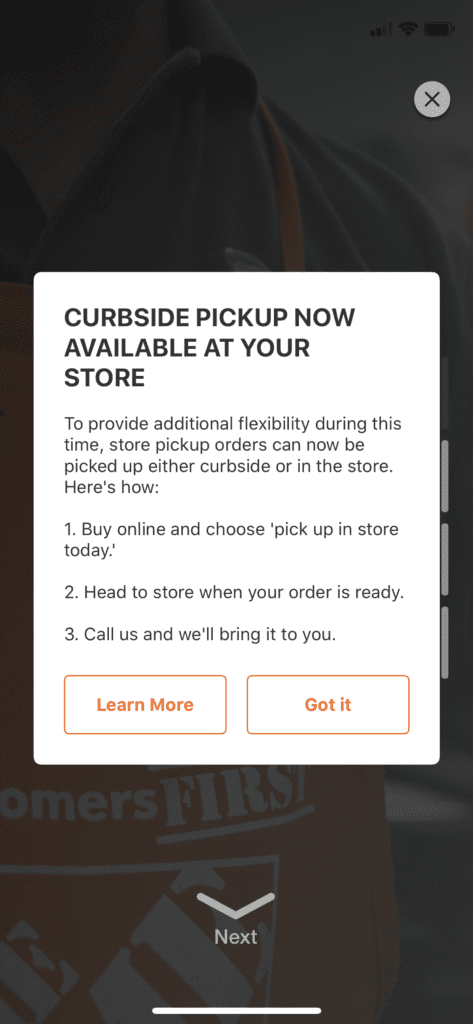

These are complex times. Make it as easy for customers to shop as possible.
Lowe’s took a slightly different approach by letting users seek out updates rather than devoting content blocks to their plans and procedures.
Each of the company’s emails came with a header linking to its newsroom where customers can find more information.
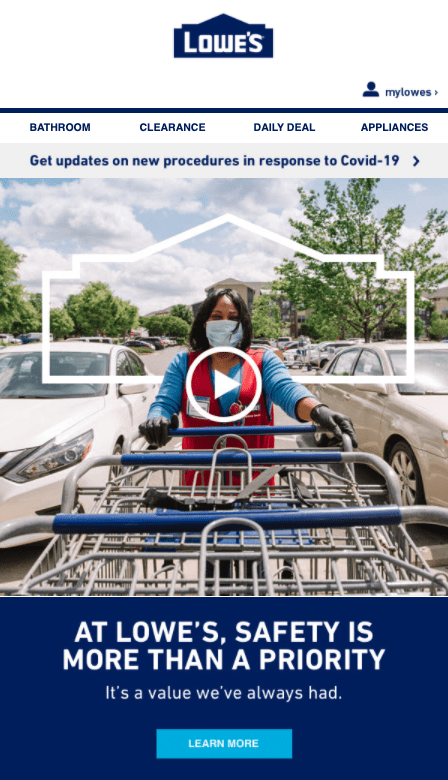

With pandemic responses changing near-daily, it’s essential to have an update hub for users to reference.
Ace Hardware also used its email header space to inform customers of the various ways to retrieve purchases.
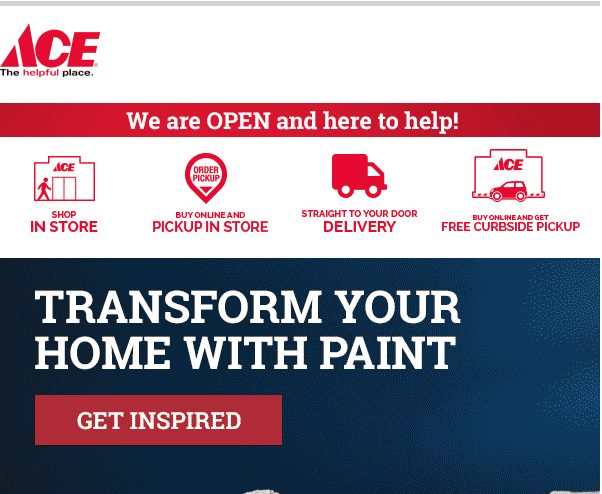

Giving customers options helps inform a more personalized journey.
By using an in-app message or hyperlinked header, these brands are educating customers about new procedures, while simultaneously collecting data that informs future lifecycle stages.
Let’s take the Ace Hardware example, for instance. The icons for the different purchase options all direct straight to the main website. If each icon were to have its own parameters, for example, Ace Hardware’s marketers would then be empowered to use this information to tailor messaging at the individual level, helping users make the most of their preferred purchasing method.
Small adjustments like these can not only improve the effectiveness of the campaign you’re currently running, but also enhance the connections that future campaigns make between your brand and your customers.
Providing a Helping Hand for DIY Projects
Despite the changing environment, home improvement brands are able to continue promotions, but with a slight tweak in focus.
Consumers across the world are staying inside as often as possible. The home is now an office, a gym, a restaurant, and a source of comfort all at once. And home improvement marketers have used this increased time spent indoors to inform their messaging.
Lowe’s opted for the more optimistic approach, prompting customers to make the most of the situation.
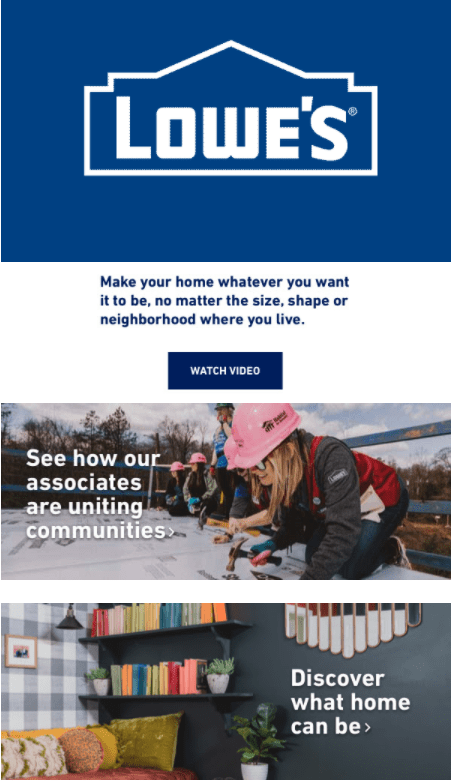

Leading with optimism in a tough time can be motivating for customers.
Meanwhile, Ace Hardware offered a variety of resources to make adding a fresh coat of paint a bit easier.
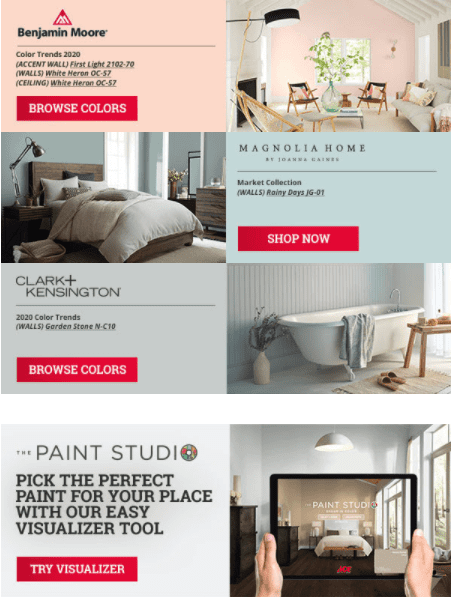

By focusing on a certain project like painting, Ace Hardware found a way to introduce a new tool—the Visualizer.
DIY jobs can be difficult. And for many homeowners, the list of potential tasks is so long it can be daunting. The bathroom needs a new coat of paint. The garage needs some new shelves. The molding is chipping away. If they’re nitpicking, the list could never end.
The Home Depot attempted to remedy this problem by sending a mobile inbox message to spark inspiration for where to start.
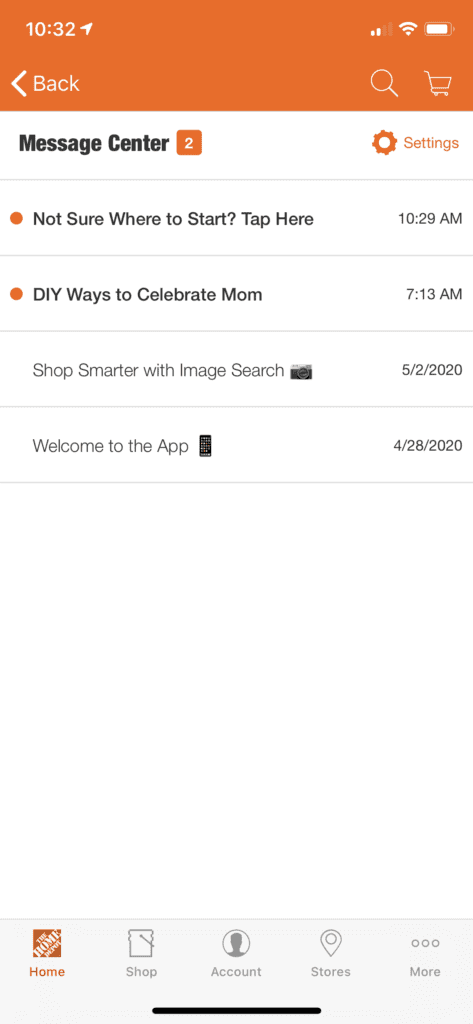

Talking to your customers like a person, not a potential purchase, goes a long way in endearing them to your brand.
At this point, marketers open up a world of opportunities for personalization. By providing the starting point in a choose-your-own-adventure style, the stage is set for an individualized campaign.
For example, if we were to start looking at paint options at Ace Hardware, the company’s follow-up messages could include more information about color principles while providing recommendations for related projects, like wood finishing for outdoor items.
Lowe’s started opening a choose-your-own-adventure customer journey by providing recommendations in their cart abandonment emails. We had looked at a chainsaw and received recommendations for a leaf-blowing and weed-clearing kit, an outdoor speaker, and a pole saw.
While the speaker might be hard to hear over all of that machinery, the idea that we could easily complete our sets to upgrade our gardening game is well presented.


Act on user behavior. Let them know you’re paying attention.
Recommendations for DIY projects are great cross-sell and upsell opportunities, as they can easily be categorized into use cases like paint, carpentry, garden, etc.
In this process, marketers can create a journey that informs the customer and offers related products that might have otherwise been missed.
A Home Improvement DIY Recommendation Engine
A recommendation is a sign of life from a brand. It’s a way to show that there is someone on the other side paying attention to the customer and looking out for their best interests.
The good news is you don’t have to come up with these recommendations on the fly. There are tools out there to keep track of your customized content collections to generate highly personalized recommendations in real time.
Sometimes there are so many possible ways to find products that it helps to hold the customer’s hand to help them find the right path. For retailers that rely on DIY projects, this hand-holding could be the difference in turning a house into a home.
Curious about creating your own data-rich recommendations for customers? Request a demo today or check out how The Dyrt used Iterable’s Catalog to make camping a personalized experience.





























